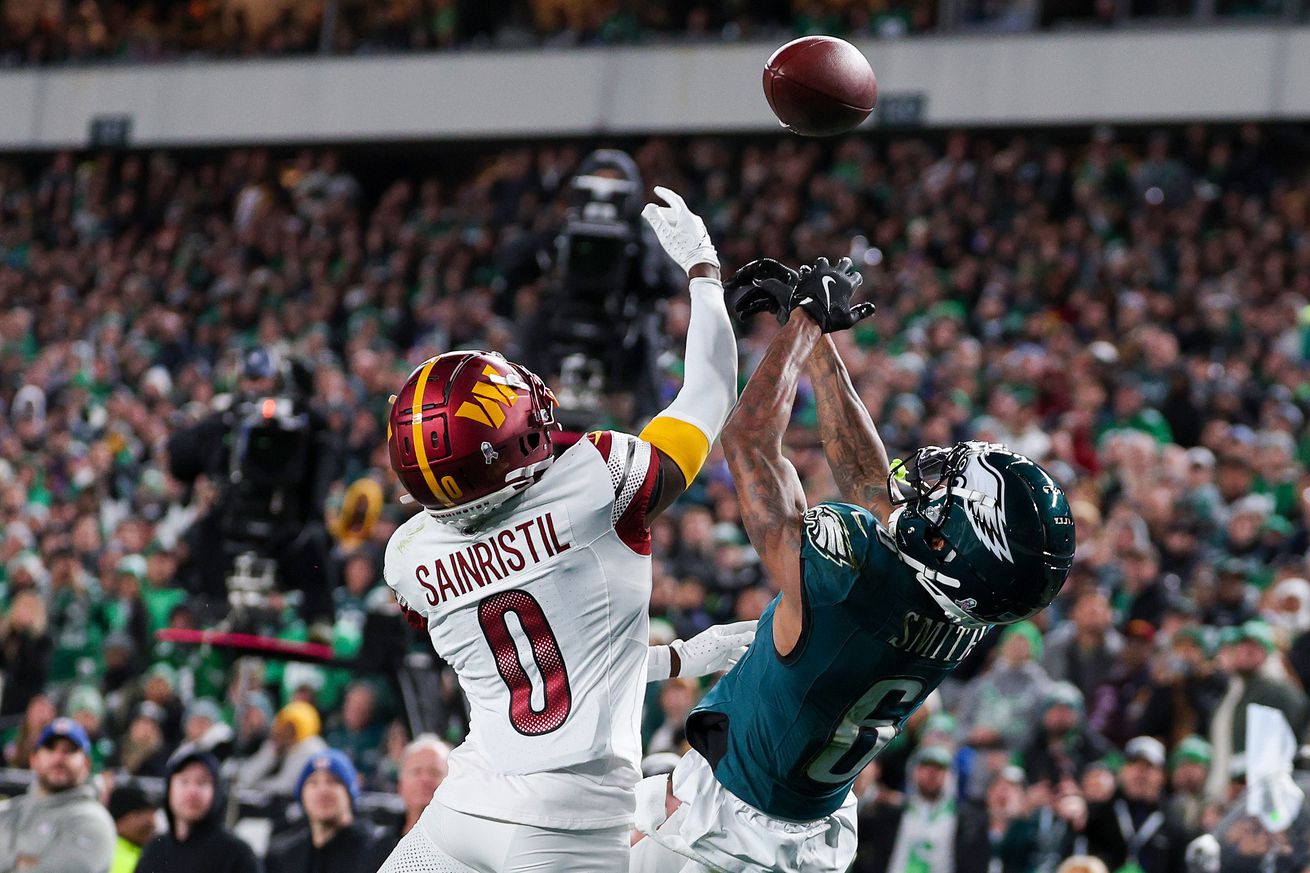
The Marshon Lattimore trade might be great value for the Commanders
The Commanders’ have a made a great start at rebuilding their roster in the first season under new management. Some areas of weakness were greatly improved in the first offseason, including interior offensive line, linebacker, and the most important position of all, quarterback.
With limited resources to fix many holes, there were bound to be remaining weak spots. Through 11 weeks of Adam Peter’s first season in charge, the Commanders have allowed the 5th most passing yards in the league, and a consensus has emerged that cornerback is the weakest link on defense. But is it all bad news at the CB position?
That’s actually a harder question to answer than it might appear. Unlike positions, such as QB, WR, RB and even LB, which produce voluminous production stats, the commonly used stats to measure CB performance are not very informative about how well players hold up on a down for down basis. Let me explain.
When people compare CBs, the usual stats that get thrown around are interceptions (INT), pass breakups (PBU aka Passes Defended – PD), and sometimes receiving yardage allowed or passer rating in coverage. All of these stats are directed at events that occur when the CB fails at his primary responsibility – locking receivers down to prevent separation and targets.
Furthermore, while there is no denying that interceptions are big plays, often game changing, they are also rare events. As of Week 11 the league interception leader at any position is Lions’ safety Kerby Joseph, with 7 picks. Since Joseph missed 1 game, that equates to 1 interception every 1.4 games. The leading ballhawk at CB is Baltimore’s Marlon Humphrey, with 5 picks in 10 games, or 1 interception every 2 games. Out of 93 starting CBs sampled in this article, only 44 (47%) have recorded an INT this season.
Does it really make sense to rate players based on something that happens less than once every game? Yes and no. Pass defense is part of the equation, but what is missing is the bigger part of a CB’s job – stopping passes from happening in the first place.
When a CB performs at elite level, he makes the receivers in his coverage disappear from the stat sheet. So, how do you measure what didn’t happen? This question has been nagging at me for two years, since I first noticed that former Washington CB Kendall Fuller seemed to be pretty good at limiting yardage of receivers he was covering, despite having fairly modest production in pass defense.
An ideal solution is probably to develop a coverage-specific DVOA-type metric, which measures how productive WRs are in an individual CB’s coverage, compared to their productivity against all the other CBs they face. But that would be extremely labor intensive, and I’m a busy guy. NGS stats on separation in coverage do exist, but they are locked up behind paywalls. What I needed was a quick and dirty solution, using no more than the two subscription stat services I already pay for (PFF, Pro Football Reference Stathead).
When I found it, the answer proved to be deceptively simple. Some might say elegant. Others might ask why it took 2 years to figure that out.
Rather than trying to tease apart the various factors that lead to CBs giving up passing yardage, such as separation allowed, rate of targets, susceptibility to deep throws, and yardage after the catch, it is simpler and better to just focus on the net effect of their coverage: receiving yards allowed. The tricky part to allow meaningful comparisons between players was to figure out how to adjust for differences in playing time and, potentially for differences in coverage roles.
After a fair bit of experimentation, I have become convinced that the best equalizer is snaps in coverage, or “coverage snaps” which is available in PFF’s premium stats.
All of that is to say that Receiving Yards/Coverage Snap (Y/Cov Snap) has passed every test I have thrown at it and emerged as a reliable metric of how well CBs perform in their primary responsibility – containing production of receivers in coverage. To get here, I had to test a few things, particularly whether Y/Cov Snap was simply a reflection of target share (it wasn’t). I won’t bore readers with methodological details now, but if anyone is interested feel free to ask questions in the comments.
How Washington’s CBs Measure Up Against the Rest of the NFL
All NFL primary starting CBs were ranked based on their overall performance in coverage based on Receiving Yards/Coverage Snap (Y/Cov Snap). The intention was to compare each of Washington’s starting CBs to the other starters in the same roles.
For each NFL team, I identified two or three “starting” CBs as follows:
CB1: The player with the most coverage snaps at boundary CB
CB2: The player with the second most coverage snaps at boundary CB
Slot CB: The CB with the most coverage snaps in the slot, if he wasn’t also CB1 or CB2
All 32 NFL teams had clearly identifiable CB1 and CB2s. Only 29 teams had clearly identifiable slot CBs, since some teams man the slot with combinations of safeties and corners or by platooning CBs. This definition of “starting” CB roles is not exactly the same that you would derive from team depth charts. It includes some backups covering for injured starters, as well as a few mis-assignments, such as Baltimore’s Marlon Humphrey, who played the most snaps in the slot amongst the Raven’s CBs, but could also be argued to be their CB1. As we’ll see, such misassignments probably don’t matter.
In addition to Y/Cov Snap, CBs were also ranked by Pass Defense Rate (PD%) which measures ballhawking. Pass Defense Rate is simply the percentage of passing targets in coverage on which a CB produced an interception or a pass breakup. Much to my surprise, ballhawking appears to be largely independent of coverage performance as indicated by low levels of correlation between PD% and Y/Cov Snap for each of the groups of starters: CB1 r = -0.21, CB2 r = -0.20, Slot CB r = 0.06.
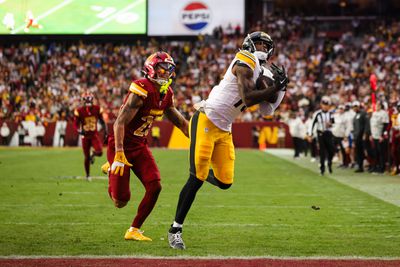
Photo by Scott Taetsch/Getty Images
CB1 – Benjamin St-Juste
For most of the season, Washington has played St-Juste as a true CB1. He has played the most defensive snaps of any CB on the team, and gets assigned to cover opposing teams’ WR1s most of the time.
2024 Stat Line:
Defense: 649 def. snaps |43 tkl | 11 asst | 1 FF
Coverage: 363 cov. snaps |7 PD | 0 INT | 62 tgt | 40 rec (64.5%) | 507 yds | 4 TDs
St-Juste has been pretty good at getting his hands on the ball, but seems to give up a lot of yardage. Let’s see how he compares to other CB1s.
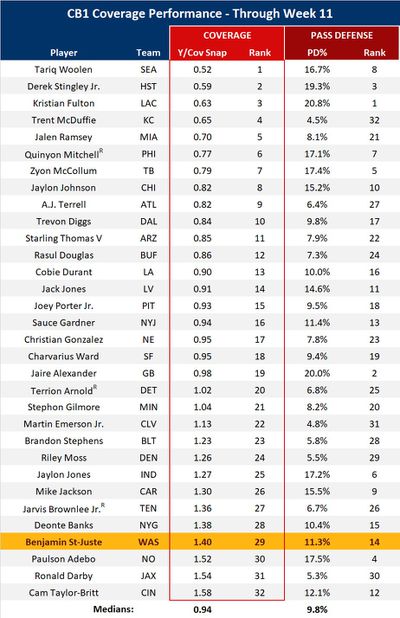
If anyone was wondering why the Commanders felt the need to trade draft picks for a veteran player with a reputation as a lockdown CB, here is your answer. The team’s current CB1 has given up an average of 1.4 Receiving Yards/Coverage Snap, which is the fourth worst figure amongst CB1s around the league.
St-Juste is a better than average ballhawk. He has the 14th highest Pass Defense Rate of 32 starting CB1s. But his ballhawking ability is not enough to make up for being the fourth most porous CB1 in coverage.
St-Juste also has a reputation for drawing penalty flags. In fact, he is only the 14th most penalized CB, with 5 flags for the season. That puts him in good company, alongside Devon Witherspoon, and behind Trent McDuffie (7), Marlon Humphrey (7), Sauce Gardner (7), and Pat Surtain II (9).
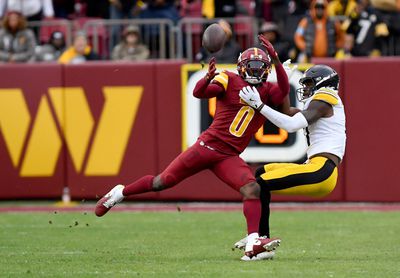
Photo by Randy Litzinger/Icon Sportswire via Getty Images
CB2 – Mike Sainristil
The diminutive rookie CB from Michigan was drafted to play Slot CB, but through a combination of circumstance has found himself playing boundary corner. He was initially moved outside due to an absence of better options. And he has stayed there, because he is much better than expected, despite his 5’9”, 182 lb Combine measurements (about the same as Darrell Green).
Until the last game, the Commanders have played Sainristil predominantly as CB2 since moving him outside. He has tended to get a little less playing time than BSJ and line up against teams’ secondary WRs. In recent games he has been holding up well against WR1s including A.J. Brown and Malik Nabers (just not George Pickens).
2024 Stat Line:
Defense: 599 def. snaps |41 tkl | 14 asst | 1 TFL
Coverage: 349 cov. snaps |5 PD | 1 INT | 48 tgt | 31 rec (64.6%) | 332 | 3 TDs
Sainristil was the 8th CB drafted in 2024. He has played the second most defensive snaps in the CB draft class, has the most tackles (47) and second most defensive stops (18), the second most pass breakups (5 PFF; 8 PFR), and is in a 6-way tie for third most interceptions. Now let’s see how he compares to all the other starting CB2’s around the league. Rookies are designated with an R.
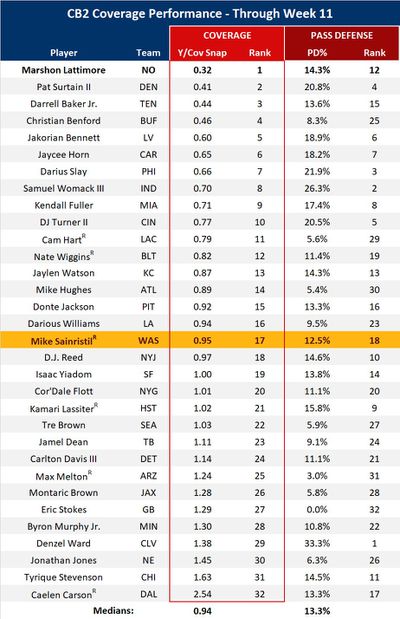
Sainristil has allowed just 0.95 Receiving Yards/Coverage Snap in his rookie campaign, which ranks a respectable 17th out of 32 starting CB2s.
Only two rookies rank above him at the CB2 position: Nate Wiggins (1st rd, 30th overall, Ravens) and Cam Hart (5th rd, 140th overall, Chargers). Across all CB positions, the only other rookies to perform better in coverage are CB1 Quinyon Mitchell (1st rd, 22nd overall, Eagles) and Slot CB Cooper DeJean (2nd rd, 40th overall – from Commanders, Eagles). That makes him the 5th best CB in coverage in the draft class, by this metric.
Sainristil has been no slouch in pass defense, either, ranking 18th among starting CB2s in Pass Defense Rate. Note that the stats I am using for this analysis are from PFF, who provide a breakdown of snaps in coverage and run defense. Pro Football Reference credits Sainristil with 8 PDs, which would likely move him up the rankings.
Marshon Lattimore: There is also another Commanders’ CB included in the CB group. Lattimore played CB1 for the New Orleans Saints, but got misclassified as a CB2 here because the 4 games he missed to injury allowed Paulson Adebo to accumulate more playing time. Regardless, Lattimore ranks 1st among all 93 starting CBs in pass coverage. In 257 coverage snaps, across 7 games, Lattimore was only targeted 14 times, giving up 83 yds. At just 0.32 Y/Cov Snap, he is the NFL’s premiere lockdown CB when healthy. He does not put up big PD and INT numbers, because receivers in his coverage are seldom targeted.
Commanders’ fans looking forward to playing Dallas might make a note that Cowboy’s rookie CB2 Caelen Carson ranks dead last among starting CB2s in pass coverage at 2.54 Y/Cov Snap. He is not just in last place in this role, either. He has the highest Y/Cov Snap value of all 93 starting CBs sampled in this analysis. Furthermore, he is in distant last place. The next worst starting CB in coverage is the Saints Slot CB Alontae Taylor at 1.75 Y/Cov Snap. Carson has given up around 45% more yardage per coverage snap than the next worst starting CB. The Commanders would do well to target him early and often.
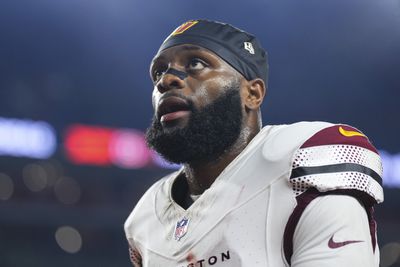
Photo by Cooper Neill/Getty Images
Slot CB – Noah Igbinoghene
Igbinoghene was one of the players that Dan Quinn took with him from Dallas. He was an unheralded FA acquisition on a 1 year, $1.125 million contract. The general feeling at the time was that he would play on special teams and provide depth at CB. Igbinoghene had been a 1st round pick by the Dolphins (30th overall, 2020 draft) but never lived up to his draft status. He started 5 games in 3 seasons in Miami and was traded to the Cowboys in 2023 and played in 5 games, mostly on special teams.
With some higher profile players failing at CB, and Sainristil moving outside, Igbinoghene got a chance to start at slot CB. He hasn’t disappointed. He has started 7 games for the Commanders and put up unexpectedly good numbers.
2024 Stat Line:
Defense: 470 def. snaps |25 tkl | 13 asst | 1 TFL
Coverage: 277 cov. snaps |4 PD | 0 INT | 48 tgt | 31 rec (64.6%) | 243 yds | 3 TDs
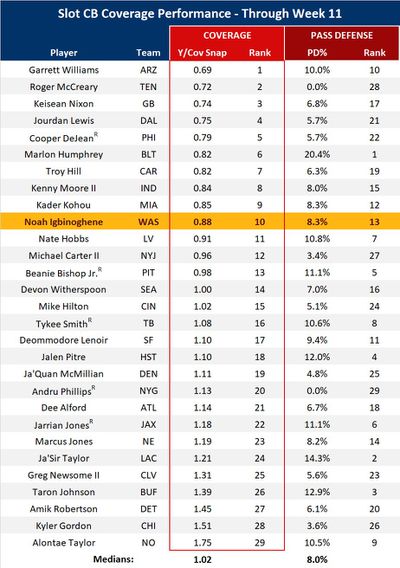
Igbinoghene has flown completely under the radar while having a very good season in his first year starting at CB. At just 0.88 Y/Cov Snap he ranks 10th best among Slot CBs at containing receivers in coverage.
While his pass defense numbers don’t jump off the page, it is actually normal for slot corners. His Pass Defense Rate is a little above average for starters in his role.
The Future at CB Is Looking Better than You Might Think
At the trade deadline, the Commanders sent 2025 third, fourth and sixth round picks to the Saints in exchange for CB Marshon Lattimore and a fifth round pick. The trade upgrades the CB1 position by replacing the fourth worst starter in coverage with the top lockdown CB in the league.
While the move was generally applauded, there were a few grumbles. Lattimore’s PD and INT numbers have declined since the 4 Pro Bowl seasons earlier in his career. But that is mainly because QBs have stopped throwing into his coverage. There is actually no indication that his skills have declined when viewed from the perspective of his ability to take receivers out of the game. His health is a concern, as he has missed 21 games in the last 4 seasons. So the move is not without risk. But if it he can stay healthy, the Commandeers will have transformed their greatest weakness on defense into a position of strength.
The other two starting CBs have been better than many people seem to appreciate. Rookie Mike Sainristil has demonstrated that he can play as a starting boundary CB, which is pretty good for a smaller CB who was drafted to play nickel. He might move back to the slot after the team adds talent in the offseason. But until then, he is more than capable of manning the CB position opposite from Lattimore.
Perhaps the biggest surprise from the coverage numbers is how well career special teamer and backup Noah Igbinoghene has performed in his first season starting at Slot CB. The Commanders might have some difficult decisions to make this offseason.
Methological Note: This analysis roughly grouped CBs by roles because I was concerned that there might be differences in Y/Cov Snap values between players with different coverage assignments. I was particularly concerned that Slot CBs might have noticeably different values from CB1s and CB2s. This is the case when comparing CBs and safeties. The latter concede significantly less yardage due to differences in coverage responsibilities. As it turned out, there was no difference in the median Y/Cov Snap values between CB1s and CB2s. The median value for Slot CBs was just 8.5% higher than the other CB roles, which is likely to be within the margin of error for these data. It does not appear that the different CB roles are associated with major differences in coverage productivity (maybe anti-productivity?).
